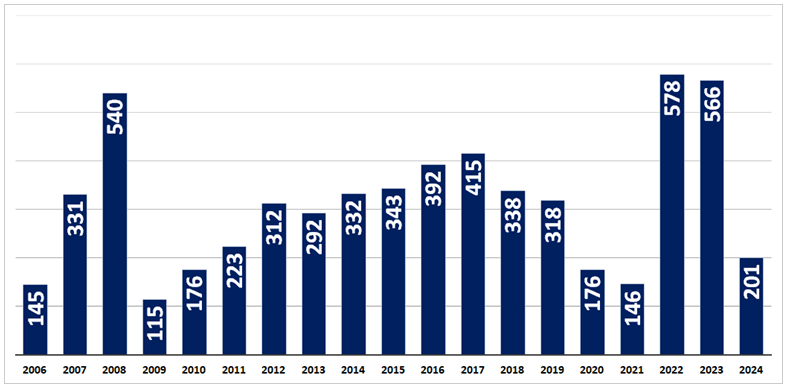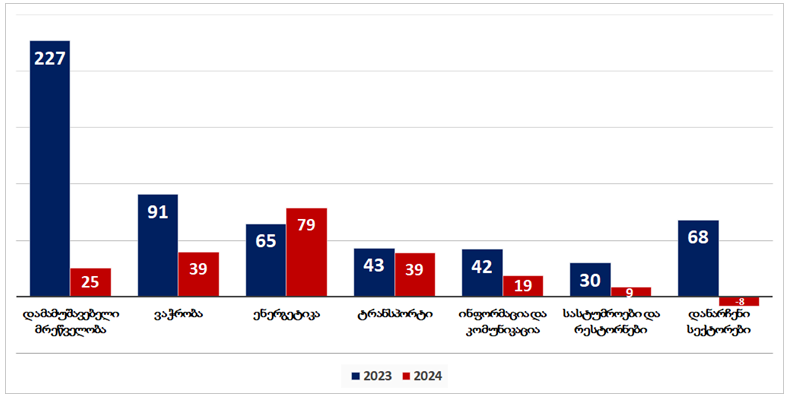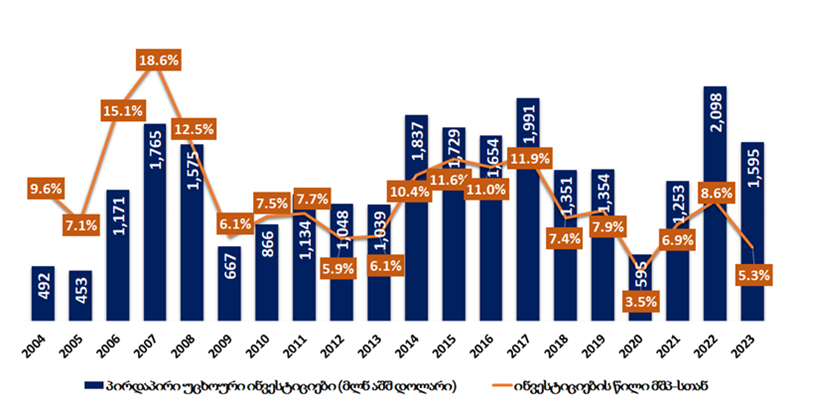Foreign direct investment (FDI) in the first quarter of 2024 sharply decreased by 64% as compared to the same period of the previous year, amounting to USD 201 million. Excluding the pandemic period (2020-2021), this is the lowest quarterly investment since 2010.
FDI is a component of the GDP and its volume directly affects the economic growth rate. Investments bring capital into the country, create jobs and generate tax revenue. In Georgia, although less common, investments in some cases also contribute to the introduction of new technologies.
Both in the first quarter and annually, investments reached their highest levels in monetary terms in 2022.
Chart 1: Foreign Direct Investment in Q1 (USD Million)

Source: National Statistics Office of Georgia
Besides USD 201 million being one of the lowest figures, the rate of decline is also record-breaking. A 64% decrease has not been recorded since 2009, with the exception of the fourth quarter of 2020, when a USD 124 million outflow of investments was registered.
Sectorally, investments mainly decreased in the manufacturing industry which shrank tenfold from USD 227 million to USD 25 million.
Chart 2: Foreign Direct Investment by Sector in Q1 (USD Million)

Source: National Statistics Office of Georgia
Despite the overall export growth last year, local exports decreased from USD 3.7 billion to USD 2.8 billion, mainly due to reduced demand for copper ore, ferroalloys and nitrogen fertilisers. While it is difficult to draw a definitive conclusion, it can be assumed that the reduced demand also decreased the desire to invest. Starting from 2024, prices for ferroalloys have begun to rise and the results will become apparent later.
According to the Deputy Minister of Finance, Giorgi Kakauridze, the decline in the sector was recorded against the backdrop of a one-time high investment and he also explained that investments generally decrease in election years.
Whilst the first quarter of 2023 did see record investments in the manufacturing industry, this cannot be the sole explanation for the decline as the first quarter of 2024 investments are also at a 14-year low in monetary terms, excluding the pandemic years.
Another explanation relates to the elections. In the past, investments usually decreased during election years but not to this extent and not always. The year 2020 is not suitable for comparison but investments decreased by 4% in 2016 as compared to 2015, although the first quarter saw a 14% increase. In 2012, there was also an 8% decrease but the first quarter saw a 40% increase. In 2008, the presidential elections were held in January and the parliamentary elections in May but despite this, the volume of foreign direct investment in the first quarter increased by 63% as compared to the same period of the previous year and by 62% in the second quarter.
When discussing investments, it is important to know the proportion of new investments versus reinvestments. In the first quarter of 2024, the share of equity capital, or new investment, decreased from 60% to 38% whilst the share of reinvestment increased from 34% to 46%. The share of debt liabilities also increased from 6% to 16%.
When a company reinvests its profits, it is a positive signal from an economic perspective. However, when the volume of new investments in one quarter is only USD 76 million, 78% less than the same period last year, this is clearly a negative event.
A total of 58% of investments in the first three months of the year came from EU countries, most notably the Czech Republic with USD 42 million and the Netherlands with USD 33 million. CIS countries account for 16% of investments, including USD 12.7 million from Azerbaijan and half of that, USD 6.4 million, from Russia which is 4.4 times less than the same period last year.
A USD 96 million outflow of investment was recorded from the UK. It is worth noting that in the first quarter of last year, a USD 26 million investment also left the country but it still ranked first with USD 392 million over all four quarters.
Another important measure of investment is its ratio to the GDP. In 2022, when investments reached a record high in monetary terms, their ratio to the GDP was 8.6%. However, before that, under a smaller economy, this ratio exceeded double digits seven times.
Chart 3: Investments to GDP Ratio

Source: World Bank
In 2023, the ratio decreased to 5.3%. It is impossible to predict the volume of foreign direct investment in the remaining three quarters. However, if we assume that the next three quarters will see roughly the same volume of investment as the same period last year, then the investment-to-GDP ratio will fall below 5% which would be the worst figure in the last 20 years, excluding 2020.
Regardless of the impact of the political environment on the economy, in this case, on investments, the decline cannot be attributed to the "Russian law" because it was initiated on 3 April at the beginning of the second quarter. Information about the second quarter's investments will become available in September.







